#justinian and theodora
Text

Justinian and Theodora romance sketch! I totally love these two as a couple-- the courtesan that married a prince!-- and there's not much art for them out there. So here it is, @byzantine-suggestions and @margaretkart!
#justinian#justinian and theodora#theodora#empress theodora#art#illustration#sketchbook#sketch#romance art#byzantine empire#byzantium#ancient rome
73 notes
·
View notes
Text
Reactionary weirdos shut up about Byzantium and Justinian & Co challenge

3 notes
·
View notes
Text

I didn’t have “teenagers making Justinian/Theodora edits of Hamilton songs on TikTok” on my 2024 bingo card, but I guess this might as well happen
#that song is not a romantic duet in Hamilton by the way#it’s a song that a father sings to/about his newborn daughter#which adds an extra level of questionableness lol#justinian and theodora
6 notes
·
View notes
Text

30 notes
·
View notes
Text
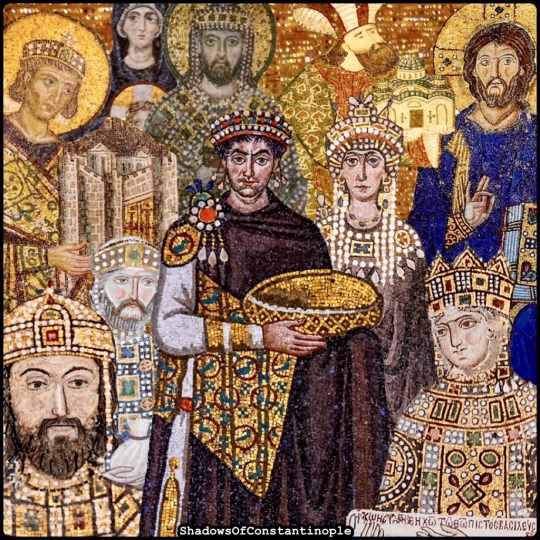
Mosaics of the Eastern Roman Empire collage.
1 note
·
View note
Text
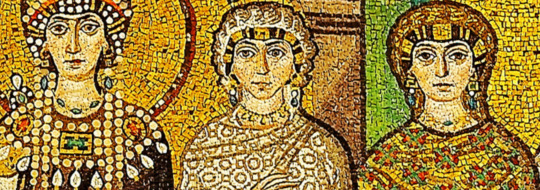
Antonina: a powerful woman in the sixth-century Roman world
"Antonina was the most powerful uncrowned woman in the sixth-century Roman world. She deposed Pope Silverius, arranged for the sacking of John the Cappadocian, traveled across the Mediterranean with her husband, and even occasionally inserted herself into the running of his army. She knew soldiers, officers, the emperor, popes, bishops, and historians, and at various times commanded them, pleaded with them, and intimidated them. This is a remarkable resume, virtually unparalleled among Roman military wives, and certainly without parallel in the sixth century. She was a formidable woman and, like her friend and patron Theodora, one who was occasionally feared. If the reputation of Belisarius is sometimes inflated in modern evaluations, the reputation of Antonina has been chronically underappreciated. Historians have focused far too much on the Secret History story of Antonina’s affair and her supposed domination of Belisarius, and far too little on her exceptional career. She is evidence that elite women in the sixth century could take on public roles alongside their husbands."
Belisarius & Antonina: Love and war in the age of Justinian, David Alan Parnell
#antonina#leaders#powerful women#history#women in history#women's history#6th century#belisarius#byzantine empire#justinian I#empress theodora
262 notes
·
View notes
Text

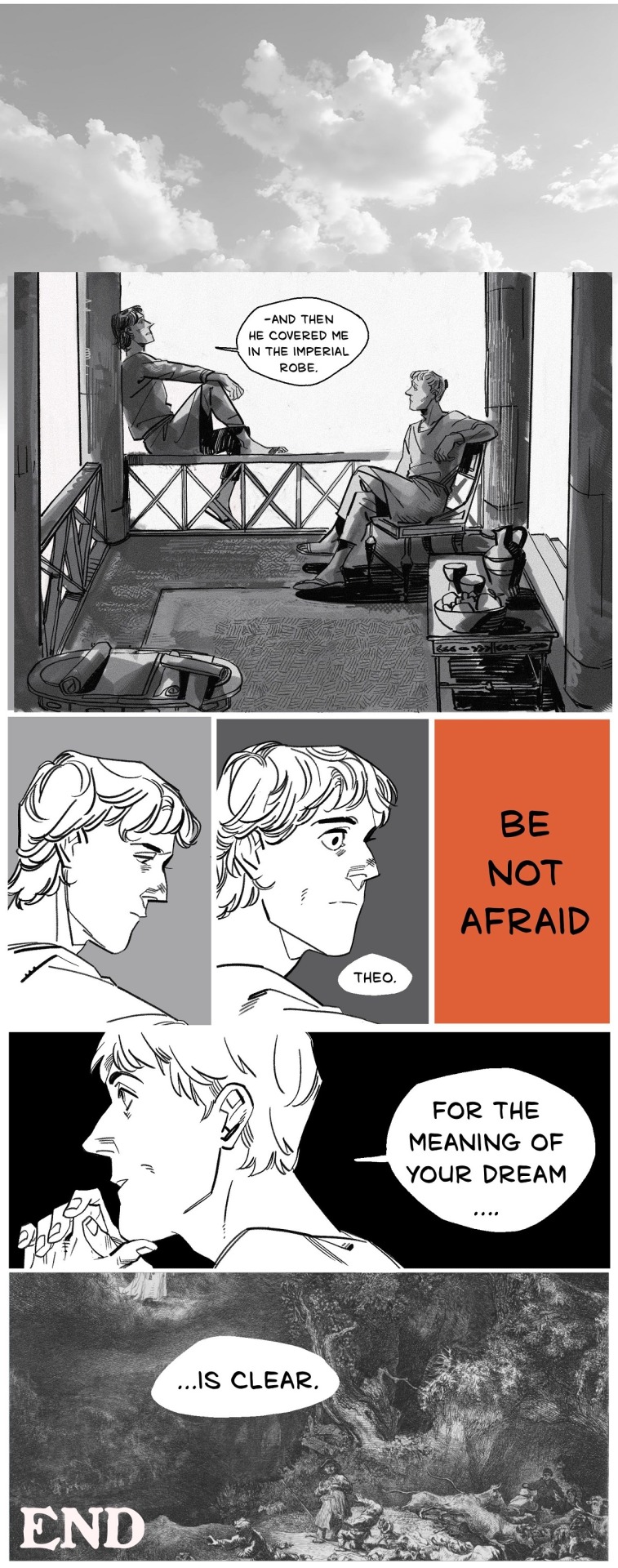
The great general remained, and then saw a wonderful vision clearly shown him by the very God of the universe himself. In it he seemed to see the divine Meletius, chief of the church of the Antiochenes, investing him with an imperial robe, and covering his head with an imperial crown. The morning after the night in which he had seen the vision he told it to one of his intimate friends, who pointed out that the dream was plain and had nothing obscure or ambiguous about it.
Theodoret Ecclesiastical History 5.6
wahoo! Theodosius! so a repeating phrase in the gospel of Luke is 'do not be afraid,' but specifically: I'm most immediately referencing the annunciation of the shepherds (Luke 2:10) because I used this illustration for the last panel since it. sort of. connects to Valens, Theodosius' predecessor, who went from commoner to king at the will of his older brother. HOWEVER. because of that transformation. I cannot escape the 'do not be afraid' just a chapter before (Luke 1:30) that Gabriel gives to Mary because ascension to the imperial throne is an ugly, violent, and violating transformation. and. well.

Gabriel’s Entrance and Biblical Violence in Luke’s Annunciation Narrative, Michael Pope
also in general. prophetic dreams and visions. horrifying. it never goes well for anyone.
⭐ places I’m at! bsky / pixiv / pillowfort /cohost / cara.app / tip jar!
#komiks tag#late roman empire tag#listen. you cant escape the absolute clusterfuck of bullshit that's going on with christian doctrine by this century#you might as well go ham or whatever. fucking. justinian and theodora were out there inventing my least favorite#divine justification for roman imperialism and its bad enough i have to suffer through it in renaissance literature discussions#UGH. anyway. might as well have fun with it while we still can.#thankfully i have no intention on going any farther than theodosius. so i can#ANYWAY#If you want to play 5-D chess I’ve also done something funky with theodosius’ gender by associating his future emperor status#with a birth narrative but that’s about as far as I’ve gone with that particular thought because there is a cassius#situation parallel I need to untangle right fucking now
268 notes
·
View notes
Text
saying "allegedly" every time i bring up a fact about any ancient figure, as in "Caligua appointed his horse consul. allegedly." because honestly we should all be worried about being sued for libel any time we use something like the Twelve Caesars as a source.
154 notes
·
View notes
Text


Early Byzantine, The Emperor Justinian and Empress Theodora with their Court Retinues, ca. 547, mosaic (San Vitale, Ravenna)
Mosaics in situ (flanking apse windows beneath Christ in Majesty mosaic), details of Emperor and Empress

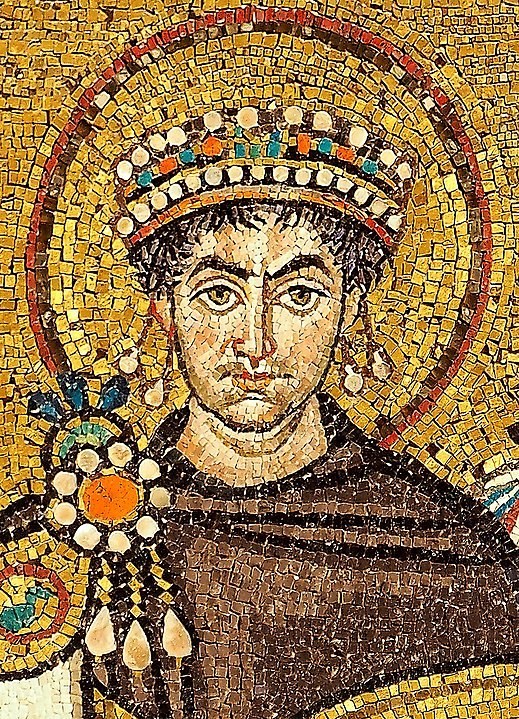

677 notes
·
View notes
Text
Empress Theodora entering Hagia Soph..
oh wait, it's Alicent.

#byzantine#byzantium#game of thrones#house of the dragon#hotd#alicent hightower#rhaenyra targaryen#daemon targaryen#hagia sophia#constantinople#roman empire#late roman empire#late antiquity#house targaryen#team green#team black#hbo#hbo max#theodora#justinian#empress
21 notes
·
View notes
Text
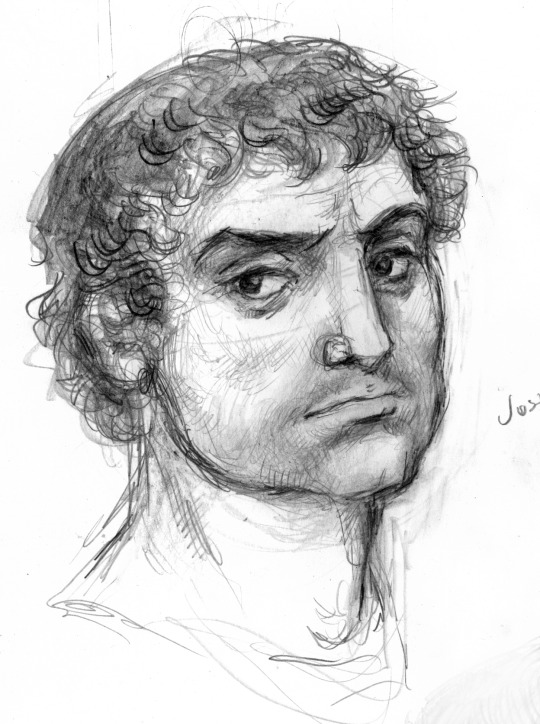
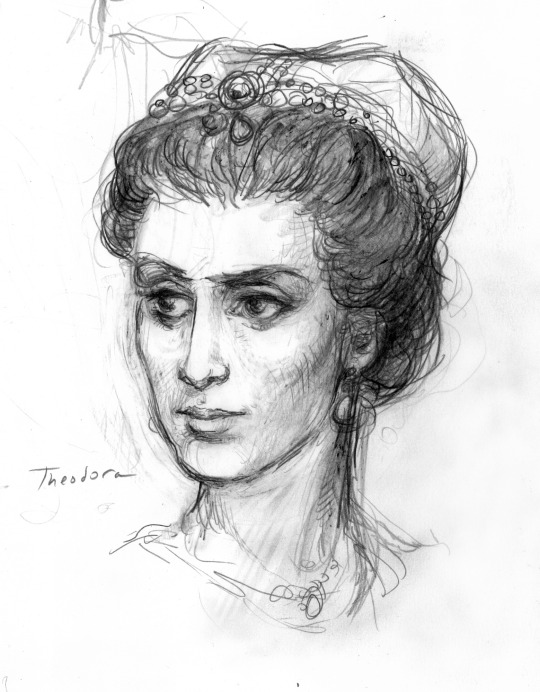
Good-bye 2023, hello 2024! One of my New Year's Resolutions is to draw more (whispers-- and to catch up on my commissions) and here are sketches of Byzantine emperor Justinian and his wife Theodora, based on the famous San Vitale mosaics and these busts of Justinian (and the bust of Theodora in Milan here).
#justinian#theodora#empress theodora#illustration#art#sketchbook#sketch#byzantium#byzantine empire#byzantine#justinian and theodora
89 notes
·
View notes
Text
‘What a fine burial shroud royalty is’ is such a raw line you wouldn’t think it comes from the same guy who wrote that a Roman emperor was a demon who could take his head off at night and killed a trillion people. But it does.
#tagamemnon#empress theodora#Procopius of Caesarea#the secret history#the wars of justinian#emperor justinian#justinian and theodora
88 notes
·
View notes
Text
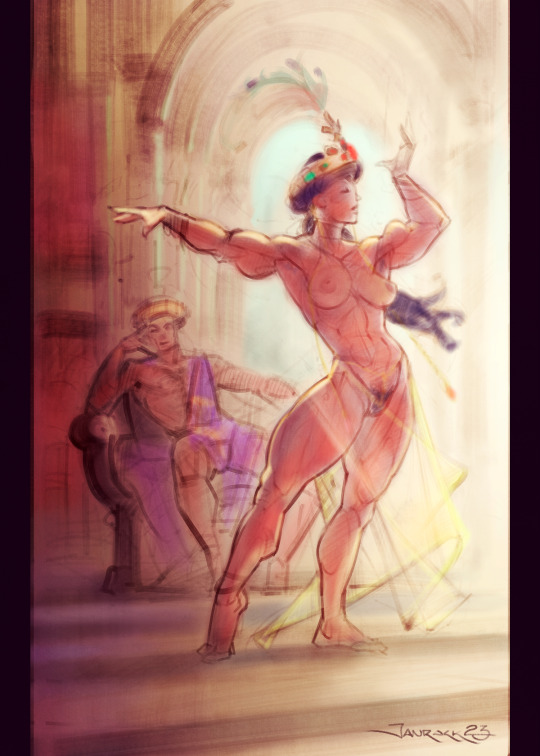
Sketching.
137 notes
·
View notes
Text
I love how the Byzantine community on Tumblr has pretty much just become us clowning on extremely cursed historical fiction adaptions of the reign of Justinian and Theodora.
13 notes
·
View notes
Text

@suburbanbeatnik OK SO:
As far as the “mixing up different historical eras” problem goes, this actually happens in a lot of different novels. Theodora by Samuel Edwards is the most blatant example I can think of at the moment—near the end of the book, a horde of Huns, inexplicably led by Khosrow, starts marching on Constantinople while Justinian is in his plague coma, and Theodora sells the crown jewels (I don’t believe the narrative specifies the buyer) to fund Belisarius and his troops, who are the city’s last defense. Khosrow is similar to Mehmed II, Theodora takes on the role of Anna of Savoy, and the overall political situation is implied to be very bad for Byzantium, with Constantinople on the brink of total failure and most of the empire's territory gone. (Like, there’s discussion of Justinian and Theodora meeting the invaders at the gates so they can die together, because they think the whole empire is collapsing.) The story does end with the Byzantines winning (using Greek fire, another anachronism), and Theodora gets her jewels back (I do not remember how), but yeah, the author completely blended two very different periods together. Different variants of this exact plot appear in different novels—a *lot* of books treat the 540s as politically similar to the 1200s or 1300s, and a *lot* of books have Theodora sell her crown for some reason or another, usually to fund the defense of the City or one of Justinian’s schemes. (One book–maybe one of the ones by Marié Heese? I can’t think of the title, sorry)—had her sell her jewels to fund the building of the Hagia Sophia. (She gets them back in that book, too—I think Narses literally just discovers an enormous stockpile of gold somewhere, and that fixes the financial problems.) And a lot of different books put Belisarius in a Heraclius or Basil-like role, although I’m less well-versed in Belisarius books than I am in Theodora books. (The Sarantine Mosaic by Guy Gavriel Kay definitely did this—the character of Leontes is pretty much Heraclius and Belisarius combined, while Valerius and Aliana are straightforward Justinian and Theodora equivalents, except for the fact Aliana is the equivalent of an iconodule rather than a Monophysite. But that gets a pass, imo, because it’s not pretending to be totally accurate.)
Religious inaccuracies and mixups are also really common overall, especially in older books. One Victorian-era book called Blue and Green, or the Gift of God: A Novel of Old Constantinople was very bad with this, presumably because the author was a British Protestant who made no secret of his disdain for the “pagan heathenism” of the Byzantine Empire. (His descriptions of religious ceremonies are very funny, because he describes them as, like, Christian ceremonies, if Christian ceremonies had strippers and drugs. The inciting incident of Theodora’s spiral into prostitution is her doing an erotic dance at a respectable, aristocratic wedding—not a bachelor party, an actual wedding—and this is presented as normal.) Really, you can probably just check out any Byzantine book from before, say, the 1980s on archive.org, and there’ll be weird religious anachronisms all over the place. Lots of authors bring iconoclasm or the East-West Schism (the one that happened in 1054) into the sixth century, I guess because those are more recognizable and dramatic than the Monophysite thing. Authors tend to put Justinian and Theodora on the opposite sides of these conflicts, and Theodora is usually on whatever side they consider “wrong,” which differs significantly from book to book depending on the author’s religious leanings.
Regarding the Theodora/Macedonia thing—Ross Laidlaw’s Justinian: The Sleepless One definitely did this (there were a couple of cringe sex scenes in this book—he always referred to Macedonia as “the other one,” I guess to avoid saying her name a bunch of times? It’d be like “Theodora felt the other one’s lips...” and so on. It sounded so strange.) Macedonia was Theodora’s main love interest—Theodora does marry Justinian, and she likes him well enough as a person, but she’s pretty explicitly gay and uninterested in men, and she has an affair with Macedonia until Macedonia dies in an earthquake. I believe Stella Duffy’s Actress, Empress, Whore duology also had Theodora and Macedonia hook up, but Duffy’s sex scenes were less fetishistic and cringeworthy, and their relationship didn’t last for the entirety of the novel. Theodora having sex (or sexually charged interactions) with Antonina, Macedonia and her other female friends is reasonably common in shitty Theodora novels in general, but it’s never, like, a plot point. It’s just an excuse for the author to write about attractive young women getting it on in the Roman baths, or whatever other fetish-y nonsense piques his interest.
These points aren’t even the weirdest things about most of these books, though. I should just sit down one day and do a full post about all of the absurd things that happen in Justinian and Theodora stories, because shit gets real weird in most of them. Messy historical anachronisms and fetish-y male-gaze lesbian sex scenes are nowhere near the strangest aspects of some of these books—remind me, one day, to talk about all of the Penis Diseases these authors invent to explain away Justinian and Theodora's infertility.
#penis disease segments#sexy Amalasuintha murder scenes#cringe Narses/Belisarius/Justinian/Theodora/Antonina love dodecahedrons#Evil Comito Bullshit#some of them give Theodora a fictional evil stepmother and stepsisters so she can be Cinderella#it's wild out there
23 notes
·
View notes
Text
The HILLSBOROUGH DISASTER has NOTHING on the NIKA RIOTS
ON THIS DAY, 532 AD



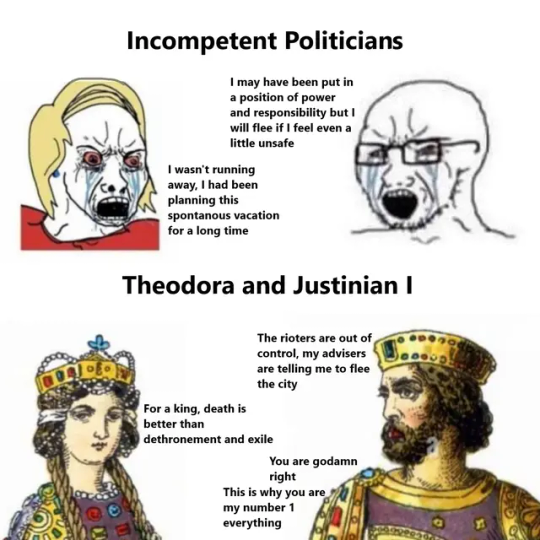

#history#ancient history#classics#ancient greek#ancient greece#ancient rome#roman#greece#constantinople#justinian#theodora#sport#sports#on this day#on this date#medieval#middle ages
19 notes
·
View notes